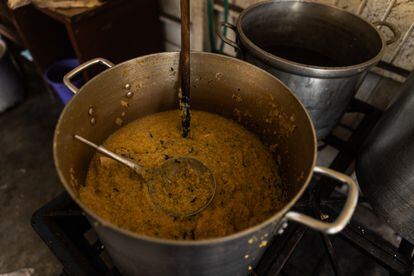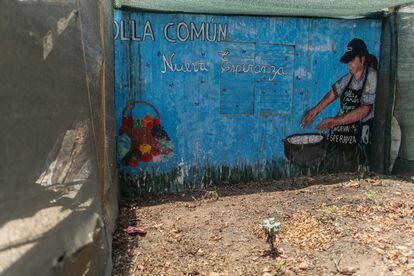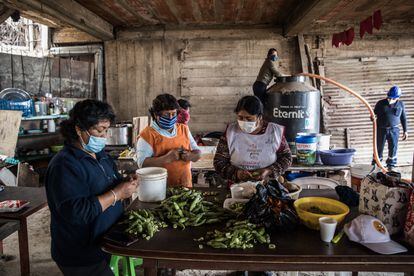EL PAÍS offers the América Futura section openly for its daily and global information contribution on sustainable development. If you want to support our journalism, subscribe here.
“One day I was leaving here, bringing food for my family, and a woman asked me to give her something to eat,” says Vilma Solier, a 39-year-old mother of a family in the 'Nueva Esperanza del Perú' communal soup kitchen, located in San Juan de Lurigancho, the most populated district of Metropolitan Lima and the country. “I gave him a part of what I brought to my house,” she adds.
Inside the small store made of wood, Mrs. Carmen Rosa Méndez still serves two young people who sell modest notebooks in these dusty streets, under a sun that cuts their skin without mercy. Three large pots placed on a stove dominate the scene, where ladles, a small table and some chairs are also seen.
Although it may seem hard to believe, in this country famous for its culinary success, many are hungry. Not just scarcity. Hunger. According to a survey by the Institute of Peruvian Studies (IEP) last September, 57% of those interviewed (1,210) revealed that in the last three months at least once their household ran out of food. In urban Peru, the percentage is 56%, while in rural Peru it is an alarming 75%, a figure that portrays the hurtful difference that separates the countryside from the cities in these lands. Or the existence of social cracks in the cities. In sectors D and E of the population, where the common pot 'New Hope' is, the percentage also reaches that terrible 75%.
“In those areas,” says the former Minister of Development and Social Inclusion (Midis). Carolina Trivellí-“Only 4% have been able to maintain their food consumption without problems.” For her, the situation is serious. And it is not explained why hunger is not seen as an immense problem. “It's not that there is no food, but that there is no economic access to it,” she adds. So much so that in the Solier pot, there are days when you cannot cook.
“Especially when there is no water,” says the woman before serving Bruno Cabrera, a 62-year-old man who walks with a limp, leaning on a cane, due to a birth defect. “I was born like this and I have never been to a hospital in my life,” he says. He is one of the 17 'social cases' of 'Nueva Esperanza', that is, someone who is not charged.
Today's menu is a quinoa stew with rice and a few pieces of chicken. It costs 3 soles (0.73 euros) and, around 2 in the afternoon, it is about to run out. The 60 diners at the communal pot, including Cabrera, have already taken their lunch and rations home. But, as Solier insists, “if someone comes to ask for food, whoever it may be, we are not going to deny it to them.”
She herself and the members, who are the ones who cook, pay two soles (0.49 euros) for each menu. And day after day, with great effort and sweat, they manage to “fill the pot.” They go to the markets and buy what they can, with the brief profit of those who pay; or “recover food”, a modality that consists of asking, at a very cheap price or as a donation, vegetables or fruits that are about to be lost. But they will take advantage wisely.

If we look at surveys from previous years of the IEP, it can be concluded that the lack of access to food is worsening: of the 17% of respondents who in 2012 said that they did not have access to food at least once in the last three months, to 57% last September. There are several factors to understand this decline. One of the great evils was the pandemic, which hit the country's poorest families hard. A good part of the common pots appeared in 2020, coinciding with the quarantine. This is the case of 'Nueva Esperanza' and 'Víctor Marcial', a pot stuck in Pamplona Alta (one of the poorest areas in all of Lima) and led by Mrs. Rossana Huamán Colque.
It is at the top of a hill, where there is no longer asphalt, and where the water is delivered by a tanker once a day. She serves 104 diners, has 20 social cases and charges 4 soles, about 0.98 euros. Today's menu is a quinoa soup and a dry (green stew) of chicken. There is also hunger around here and there are dramatic family scenes.
Francisca Guzmán, one of the members, has eight mouths to feed. Her husband beat her, until six years ago she demanded that he leave her. She now lives with her four children and four other relatives, in a three-bedroom house. She goes to the common pot every day to work and bring them food. Some days in the past, she remembers eating only fried eggs and rice.

He has never been to a pollería (restaurant that sells grilled chickens), something that most Peruvians, even poor, can do at some point. Cook from Monday to Friday at 'Víctor Marcial'. On Saturdays and Sundays, he washes clothes or cleans houses in wealthy areas of Lima. He practically never rests. But he doesn't curse, he doesn't breathe fire for his situation. Fight and work.
They are among the group that, according to the IEP survey, had problems obtaining food, or had to reduce their consumption due to high prices (70% of those surveyed). Women, along with children, are the most affected. In Latin America, according to Help in Actionthe difference in food security between men and women is 11.3%.
The dramatic numbers
In the year 2022, the FAO reported that Peru was the country with the most food insecurity in all of South America. This has continued and, in addition to the pandemic, the war in Ukraine, which made fertilizers scarce, or the 'Yaku' cyclone, which in 2023 ruined crops in several parts of the country, have had an influence. But also public disinterest and state. Peru's global culinary rise causes much more stir than the hunger suffered by a large part of its population.
Trivelli believes that there should be a special body at the highest level of the State, and an official with power to lead the strategy to confront the drama. Because the figures continue to speak: the Global Hunger Index (GHI), presented last year, warns about the 16 million Peruvians who suffer from a nutritional deficiency, which would have caused anemia levels to skyrocket to the devastating figure of 43.6% of children between 8 and 35 months affected by this deficiency.

Sociologist Fernando Eguren notes another worrying angle: in addition to children, other groups vulnerable due to meager food are prisoners, the elderly, the sick without resources, and even foreign migrants, who even beg for alms on the streets of Lima. He emphasizes, at the same time, that climate change is very relevant in this worrying panorama.
It is already severely affecting agriculture, especially family agriculture, which, according to what it says, produces about 60% of food. that the population consumes. The global phenomenon hits the production of potatoes and other foods, as well as sea and Amazon fishing.
The reduction of Andean glaciers, Eguren points out in a text soon to be published, is already impacting lakes, rivers and puquios (small water bodies that exist especially in the mountains). Not to mention the droughts, which in 2023 caused Puno, a southern Andean department, to suffer the driest year in the last 59 years. All are factors that further impact food security.
The pots do not give up
Against every storm, the fences of the more than 3,500 common pots in Peru (most in Lima) fight daily to offer the providential plate of food. Abilia Ramos, president of 'Nueva Esperanza del Perú', who also knows about times of hunger, explains that although the Ministry of Development and the municipality of Lima help, they themselves cover 75%.
During the pandemic, with signs asking for donations in the markets; now, selling desserts, drinks or holding polladas (meetings where roast chicken is sold to raise funds). “We are solving the problem for the State and they don't realize it,” he emphasizes. On the dusty hills and in the middle of steep streets, he battles daily to not leave the poor, and the poorest of the poor, without food. Asked what he thinks of Peru's culinary triumphs, he is clear: “It makes me very proud. But it is not the only thing that exists in our country.”

#Hunger #land #culinary #success